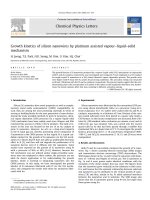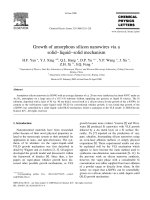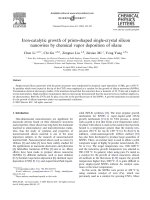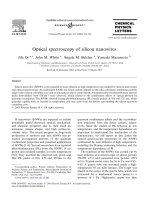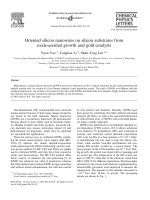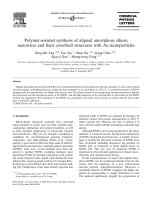- Trang chủ >>
- Khoa Học Tự Nhiên >>
- Vật lý
Growth of amorphous silicon nanowires
Bạn đang xem bản rút gọn của tài liệu. Xem và tải ngay bản đầy đủ của tài liệu tại đây (533.31 KB, 6 trang )
Growth of amorphous silicon nanowires
Z.Q. Liu, W.Y. Zhou, L.F. Sun, D.S. Tang, X.P. Zou, Y.B. Li,
C.Y. Wang, G. Wang, S.S. Xie
*
Group 412, Center for Condensed Matter Physics, Institute of Physics, Chinese Academy of Sciences,
P.O. Box 603-32#, Beijing 100080, People's Republic of China
Received 16 February 2001; in ®nal form 4 April 2001
Abstract
We have grown vertically aligned amorphous silicon nanowires on Au±Pd co-deposition silicon oxide substrate by
thermal chemical vapor deposition using SiH
4
gas at 800°C. The diameter of silicon nanowires is in the range 10±50 nm
and the length is about 1 lm. Transmission electron microscopy (TEM) observations show that the grown silicon
nanowires are of an amorphous state and some of nanowires appear to bifurcate in the vertically growth process. The
eect of H
2
gas etchings on the catalytic size and the eect of catalytic size on the formation of the vertical growth
nanowires are discussed. Ó 2001 Elsevier Science B.V. All rights reserved.
1. Introduction
Nano-materials are attracting much attention
because of the electronic, magnetic, optical, bio-
logical, and chemical characteristics they have that
are not obtained with conventional materials.
Among these low-dimensional materials, one-
dimensional materials, such as nanotubes [1±4],
semiconductor nanowires [5±10] and metal nano-
wires [11] have been of recent heightened interest
because these materials oer fundamental scien-
ti®c opportunities for investigating the in¯uence of
size and shape with respect to optical, electronic,
and mechanical properties. For silicon, it is
promising to emit visible light by reducing its
dimension, in which the motion of carriers is
con®ned, causing a possible transformation of the
electronic band structure from indirect band gap
to direct band gap. This has stimulated intensive
interest in preparing silicon nanowires. In addi-
tion, if such wires can be ordered and assembled
into appropriate architectural environment, then a
host of nanoelectronic applications can be envi-
sioned. Until now controlling the size and length
of these synthesized nanomaterials have been
practical problems, which seriously restrict the
future applications. To date, silicon nanowires
have been successfully prepared through dierent
ways, such as excimer laser ablation [5,6], chemical
vapor deposition (CVD) [12,13], stress limited
oxidation [14,15]. However, all of these previous
studies have got crystalline state silicon nanowires
with a thin oxide outer layer. Amorphous state
silicon nanowires have been reported very slightly.
Recently, Yan et al. [16] have prepared amor-
phous silicon nanowires via a solid±liquid-solid
mechanism.
Among the above-mentioned growth tech-
niques, the CVD process may have its special
bene®ts that one can more easily control the
29 June 2001
Chemical Physics Letters 341 (2001) 523±528
www.elsevier.nl/locate/cplett
*
Corresponding author. Fax: +86-10-8264-9531.
E-mail address: (S.S. Xie).
0009-2614/01/$ - see front matter Ó 2001 Elsevier Science B.V. All rights reserved.
PII: S 0 0 0 9 - 2 6 1 4 ( 0 1 ) 0 0 513-9
nucleation site as well as dierentiate between
growth and tail ends of the nanowires. In this
Letter, we use chemical vapor deposition of silane
to prepare silicon nanowires. Our research group
had previously reported the growth amorphous
silicon nanowires on AuPd/SiO
2
/Si substrates by
using thermal chemical vapor deposition [17]. We
extend the work of H
2
gas etchings to the nano-
wires growth. The eect of H
2
gas etchings on the
catalytic size and the eect of the catalytic particle
size on the diameter and alignment of amorphous
silicon nanowires are discussed. Bifurcate phe-
nomena morphology was found in vertical growth
process.
2. Experimental
The substrates used in our experiments were
8 X cm n-type Si(1 0 0) wafers with an oxide layer
about 60 nm in thickness. They were ultrasoni-
cally stirred for 30 min in acetone solution to
clean their surfaces. The cleaned substrates were
then deposited with Au±Pd ®lm about 0.5 and
1 min under 10
À1
Torr at 100 V and 20 mA by
using ion sputter ®lms deposition system (Hitachi,
E-1010). The thickness of the Au±Pd alloy ®lm
was estimated as approximately 5 nm and 10 nm,
respectively. Put them into a tube furnace that has
been described elsewhere [18]. Prior to deposition,
the Au±Pd alloy-coated substrates were pretreated
in ¯oating H
2
gas for approximately 180 min. The
purpose of this pretreatment was to break the
smooth Au±Pd alloy ®lms into discrete islands
and then control the size of the catalytic size.
After pretreatment, the silane gas was introduced
into the reactor for the start of deposition stage.
The pretreatment and deposition parameters are
listed in Table 1.
The as-grown silicon nanowires were examined
by a ®eld-emission scanning electron microscope
(SEM; S-4200, Hitachi), and energy-dispersive
X-ray (EDX) spectra were recorded by SiLi
detector attached to SEM. A transmission electron
microscope (TEM; JEOL JEM-200 CX at 200 kV)
was used to characterize the structures of silicon
nanowires.
3. Results and discussio n
Fig. 1a±d shows the SEM images of the silicon
nanowires grown on a substrate, which was de-
posited with AuPd alloy as catalyst for 10 nm. Fig.
1a shows that large amounts of nanowires are
formed, which are of a uniform length up to
2 micrometers. The growth rate of the nanowires is
estimated to be ca. 15 nm/min. The diameter of the
nanowires is about 40 nm. A lot of nanowires are
assembling along the same direction and are not
parallel to the surface of the substrate (see Fig.
1a,b). All of the nanowires are terminated by the
nanoparticles with the diameter about 60±80 nm at
their tips (see Fig. 1c). Some of the nanowires
become curved near their tops. The EDX spectra
taken from these nanoparticles showed the pres-
ence of gold, palladium, oxygen and silicon (0.6,
0.3, 26.6 and 72.5 at%, respectively). Compared
with the nanoparticles, the nanowires are com-
posed of silicon and a small amount of oxygen,
indicating that no catalytic elements exist in the
nanowires. Top view of the nanowires is shown in
Fig. 1d. An interesting phenomenon is that bifur-
cation of the nanowires was found at the tail of the
nanowires (see arrowhead in Fig. 1b,d)
High-resolution TEM was employed to detect
the structure of the nanowires in detail. Using an
ultrasonic treatment in alcohol solution for 30 min,
Table 1
Pretreatment and depostion parameters
Pretreatment Depostion
Gas H
2
/He SiH
4
/He
Pressure (Torr) 150 150
Flow rate (Sccm) 10/100 10/100
Temperature (°C) 800 Æ 10 800 Æ 10
Time (min) 180 60
524 Z.Q. Liu et al. / Chemical Physics Letters 341 (2001) 523±528
the nanowires were separated from the substrate.
And then we dropped the solution to the copper
grid for TEM observation. From Fig. 2a, we can
see that the nanowires are of a uniform diameter
about 40 nm and have smooth surfaces. Further-
more, TEM reveals that the nanowires are in a
perfect amorphous state. The selected-area elec-
tron diraction of silicon nanowires shown in the
inset of Fig. 2a con®rms this point.
In our TEM observation, we also found a bi-
furcation phenomenon of amorphous silicon
nanowires. Fig. 2b±d shows the dierent bifurca-
tion morphologies of the nanowires. `Y' shape (see
Fig. 2b) and `T' shape (see Fig. 2c) junctions are
found. The smooth curvatures associated with the
junctions suggest that these structures were actu-
ally formed during the growth process, rather than
during TEM observations. More complex inter-
connections containing metal catalyst are also
found (see Fig. 2d).
In order to see the eect of the catalytic particle
size on the diameter and alignment of amorphous
silicon nanowires, we also use the substrate, which
has been sputtered with Au±Pd alloy thickness of
about 5 nm. The growth process is the same as 10
nm Au±Pd deposited substrate. Fig. 3a±b shows
the SEM images of the nanowires grown on 5 nm
Au±Pd deposited substrate. Comparing with the
Fig. 1. SEM images of the silicon nanowires grown on a substrate deposited with AuPd alloy as catalyst for 1 min. (a) Low-mag-
ni®cation images of silicon nanowires. (b) and (c) A magni®ed view of (a). (d) Top view of the vertically aligned silicon nanowires.
Z.Q. Liu et al. / Chemical Physics Letters 341 (2001) 523±528 525
thicker Au±Pd alloy ®lms, we can see that the di-
ameter of the nanowires is 30 nm. The alignment
of the nanowires is improved.
Compared with our previously work [17], we
got amorphous aligned silicon nanowires instead
of the randomly distributed nanowires. The only
dierence in our experiment is that the substrates
were pretreated by H
2
etching before the nano-
wires growth. For comparison, the substrate which
only annealed in ¯uent He without H
2
etching was
also studied. Fig. 4a show the SEM image of the
unetching substrate with 5 nm Au±Pd ®lms. From
Fig. 4 we can see that AuPd ®lms on the substrate
have broken up to form a large amount of nano-
particles. The nanoparticles size are uniform and
are of about 30 nm diameter. However, when the
substrate was pretreated with ¯uent H
2
under the
same condition, the diameter of the nanoparticles
(see Fig. 4b) become smaller than that of the
nanoparticles shown in Fig. 4a. It con®rmed that
H
2
etching really plays a positive role in control-
ling and deducing the catalytic size. The decreasing
size of the catalyst may result in the aligned growth
of the nanowires.
We think that vapor±liquid±solid (VLS) mech-
anism accounts for the amorphous state silicon
nanowires growth in our experiment. The mecha-
nism has been put forward by Wagner and Ellis
Fig. 3. SEM images of the nanowires grown on 5 nm Au±Pd
deposited substrate. (a) Low-magni®cation images of silicon
nanowires. (b) A magni®ed image of (a).
Fig. 2. TEM images of the silicon nanowires dispersed on a
carbon-coated copper microgrid. (a) A low-resolution TEM
image of the nanowires, the inset is the selected-area electron
diraction of the nanowires. (b)±(d) The bifurcation structure
of the silicon nanowires.
526 Z.Q. Liu et al. / Chemical Physics Letters 341 (2001) 523±528
[19] It is well know that the impurity agent, which
plays an important role in the formation of pref-
erential growth ®ber, will be found at the tip of the
obtained nanowires. The SEM images (shown in
Fig. 1) con®rm this point. We propose a model to
explain the bifurcation growth process under VLS
growth mechanism (see diagram in Fig. 5). During
the aligned nanowires growth process, some of the
nanowires will form kinks due to the weight of the
catalyst on their tip. It may be easy for the melting
catalytic nanoparticles on its top to meet together
and coalesce to become a larger catalyst. From
Fig. 1, we found that the size of catalyst on the tip
of the nanowires become larger than that of the
particles shown in Fig. 4b. In the end, the bifur-
cation growth is formed.
4. Conclusion
Aligned amorphous silicon nanowires on a
large scale of Au±Pd co-deposition silicon oxide
substrate by thermal chemical vapor deposition
were obtained. The catalytic particle size of Au±Pd
catalysts decreases, the diameter of the nanowires
decreases and the vertical alignment is enhanced.
H
2
pretreatment before growth can deduce the
catalytic nanoparticles sizes. There are bifurcation
Fig. 5. Schematic diagrams of the bifurcation growth model.
Fig. 4. SEM images of the annealing substrates with 5 nm
Au±Pd ®lms at 800°C for 180 min. (a) without H
2
gas etching,
(b) with H
2
gas etching.
Z.Q. Liu et al. / Chemical Physics Letters 341 (2001) 523±528 527
growth phenomena in this kind of aligned growth
process.
Acknowledgements
This work is supported in part by the National
Natural Science Foundation of China.
References
[1] S. Iijima, Nature (London) 354 (1991) 56.
[2] O. Stephan, P.M. Ajayan, C. Colliex, P. Redich, J.M.
Lambert, P. Bernier, P. Le®n, Science 266 (1994) 1683.
[3] N.G. Chopra, R.J. Luyken, K. Cherrey, V.H. Crespi, M.L.
Cohen, S.G. Louie, A. Zettl, Science 269 (1995) 966.
[4] L. Margulis, G. Salitra, R. Tenne, M. Talianke, Nature
(London) 360 (1992) 444.
[5] A.M. Morles, W.C. Lieber, Science 279 (1998) 208.
[6] Y.F. Zhang, Y.H. Tang, N. Wang, D.P. Yu, C.S. Lee,
I. Bello, S.T. Lee, Appl. Phys. Lett. 72 (1998) 1835.
[7] M. Fujii, H. Iwanaga, N. Shibata, J. Cryst. Growth 99
(1990) 179.
[8] K. Hiruma, T. Katsuyama, K. Ogawa, G.P. Morgan,
M. Koguchi, H. Kakibayashi, Appl. Phys. Lett. 59 (1991)
431.
[9] Z.L. Wang, Z.R. Dai, Z.G. Bai, R.P. Gao, J. Gole, Appl.
Phys. Lett. 77 (2000) 3349.
[10] Z.L. Wang, R.P. Gao, J.L. Gole, J.D. Stout, Adv. Mater.
12 (2000) 1938.
[11] A. Kida, H. Kajiyama, S. Heike, T. Hashizume, K. Koike,
Appl. Phys. Lett. 75 (1999) 540.
[12] J. Westwater, D.P. Gosain, S. Tomiya, S. Usui, H. Ruda,
J. Vac. Sci. Technol. B 15 (1997) 554.
[13] N. Ozaki, Y. Ohno, S. Takeda, Appl. Phys. Lett. 73 (1998)
3700.
[14] H. Liu, D.K. Biegelsen, N.M. Johnson, F.A. Ponce,
R.F.W. Pease, J. Vac. Sci. Technol. B 13 (1995) 2166.
[15] H. Liu, D.K. Biegelsen, N.M. Johnson, F.A. Ponce,
R.F.W. Pease, Appl. Phys. Lett. 64 (1994) 1385.
[16] H.F. Yan, Y.J. Xing, Q.L. Hang, D.P. Yu, Y.P. Wang,
J. Xu, Z.H. Xi, S.Q. Feng, Chem. Phys. Lett. 323 (2000)
224.
[17] Z.Q. Liu, Z.W. Pan, L.F. Sun, D.S. Tang, W.Y. Zhou,
G. Wang, L.X. Qian, S.S. Xie, J. Physics and Chemistry
of Solids 61 (2000) 1171.
[18] W.Z. Li, S.S. Xie, L.X. Qian, B.H. Chang, B.S. Zhou,
W.Y. Zhou, R.A. Zhao, G. Wang, Science 274 (1996) 1701.
[19] R.S. Wagner, W.C. Ellis, Appl. Phys. Lett. 4 (1964) 89.
528 Z.Q. Liu et al. / Chemical Physics Letters 341 (2001) 523±528


